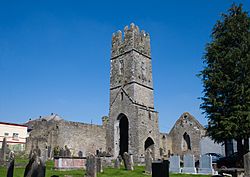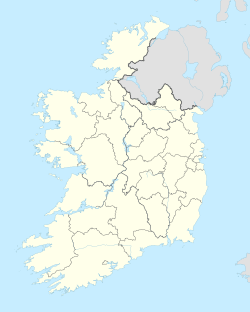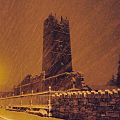Roscrea Friary facts for kids
| Mainistir Ros Cré | |

The abbey church
|
|
| Monastery information | |
|---|---|
| Order | Order of Friars Minor Conventual (before 1477) Order of Friars Minor (1490 on) |
| Established | before 1477 |
| Disestablished | c. 1579 |
| Diocese | Killaloe |
| People | |
| Founder(s) | Maelruanaid O Cerbaill |
| Architecture | |
| Status | Inactive |
| Style | Late Gothic |
| Site | |
| Location | Abbey Street, Roscrea, County Tipperary |
| Coordinates | 52°57′09″N 7°47′59″W / 52.952518°N 7.799660°W |
| Public access | yes |
| Official name | Roscrea Friary |
Roscrea Friary is an old Franciscan monastery and an important historical site in Roscrea, Ireland. It is located on Abbey Street, in the western part of Roscrea, next to the River Bunnow. This special building was started in the 1400s by a group of monks called the Greyfriars, who are also known as Franciscans. Sadly, it was later damaged by British soldiers. Today, you can still see some of its walls and a tall bell tower.
The Story of Roscrea Friary
People believe that the very first monastery in this spot was built by a person named Crónán of Roscrea way back in the year 640.
The Roscrea Friary we see today was founded before 1477. It was started by a group of Franciscan monks called the Order of Friars Minor Conventual. The person who helped set it up was Maolruanaidh Ó Cerbaill, who was a local king, and his wife Bibiana.
Around 1490, the friary changed to a different group of Franciscan monks, called the Order of Friars Minor. The buildings you can see now were mostly built around that time.
Sadly, the friary was closed down and destroyed by English soldiers between 1577 and 1579. This was part of a time when many monasteries were being closed.
What's Left of the Buildings
Today, you can still see the north and east walls of the friary. The most noticeable part is the tall, central bell-tower.
The bell-tower has two levels and looks like a castle at the top because it has crenellated edges (square gaps like on a castle wall). The tower stands on strong, pointed arches. These arches have special carved decorations underneath them and are supported by stone brackets called corbels.





